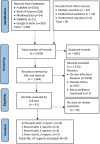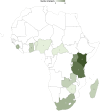Availability of published evidence on coverage, cost components, and funding support for digitalisation of infectious disease surveillance in Africa, 2003-2022: a systematic review
- PMID: 38943132
- PMCID: PMC11214246
- DOI: 10.1186/s12889-024-19205-2
Availability of published evidence on coverage, cost components, and funding support for digitalisation of infectious disease surveillance in Africa, 2003-2022: a systematic review
Abstract
Background: The implementation of digital disease surveillance systems at national levels in Africa have been challenged by many factors. These include user applicability, utility of IT features but also stable financial support. Funding closely intertwines with implementations in terms of geographical reach, disease focus, and sustainability. However, the practice of evidence sharing on geographical and disease coverage, costs, and funding sources for improving the implementation of these systems on the continent is unclear.
Objectives: To analyse the key characteristics and availability of evidence for implementing digital infectious disease surveillance systems in Africa namely their disease focus, geographical reach, cost reporting, and external funding support.
Methods: We conducted a systematic review of peer-reviewed and grey literature for the period 2003 to 2022 (PROSPERO registration number: CRD42022300849). We searched five databases (PubMed, MEDLINE over Ovid, EMBASE, Web of Science, and Google Scholar) and websites of WHO, Africa CDC, and public health institutes of African countries. We mapped the distribution of projects by country; identified reported implementation cost components; categorised the availability of data on cost components; and identified supporting funding institutions outside Africa.
Results: A total of 29 reports from 2,033 search results were eligible for analysis. We identified 27 projects implemented in 13 countries, across 32 sites. Of these, 24 (75%) were pilot projects with a median duration of 16 months, (IQR: 5-40). Of the 27 projects, 5 (19%) were implemented for HIV/AIDs and tuberculosis, 4 (15%) for malaria, 4 (15%) for all notifiable diseases, and 4 (15%) for One Health. We identified 17 cost components across the 29 reports. Of these, 11 (38%) reported quantified costs for start-up capital, 10 (34%) for health personnel compensation, 9 (31%) for training and capacity building, 8 (28%) for software maintenance, and 7(24%) for surveillance data transmission. Of 65 counts of external funding sources, 35 (54%) were governmental agencies, 15 (23%) foundations, and 7 (11%) UN agencies.
Conclusions: The evidence on costing data for the digitalisation of surveillance and outbreak response in the published literature is sparse in quantity, limited in detail, and without a standardised reporting format. Most initial direct project costs are substantially donor dependent, short lived, and thus unsustainable.
Keywords: Africa; Costing data; Coverage; Digital systems; Funding; Implementation; Infectious diseases; Outbreak response; Surveillance; Sustainability.
© 2024. The Author(s).
Conflict of interest statement
The authors declare no competing interests.
Figures





References
-
- Kelly C, Kamil-Thomas Z. Digital Health Technologies: Digital Innovations in Public Health. In: Leal Filho W, Wall T, Azul AM, Brandli L, Özuyar PG, editors. Good Health and Well-Being [Internet]. Cham: Springer International Publishing; 2020 [cited 2024 May 7]. pp. 119–30. (Encyclopedia of the UN Sustainable Development Goals). http://link.springer.com/10.1007/978-3-319-95681-7_70.
-
- Strengholt P. Data Management at Scale. O’Reilly Media, Inc.; 2023.
Publication types
MeSH terms
LinkOut - more resources
Full Text Sources
Medical

